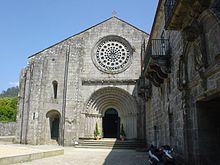Armenteira Monastery
| Armenteira Cistercian Abbey | |
|---|---|
| location | Spain Galicia |
| Coordinates: | 42 ° 27 '47 " N , 8 ° 44' 50" W |
| Serial number according to Janauschek |
371 |
| Patronage | St. Mary |
| founding year | 1162 |
| Year of dissolution / annulment |
Reoccupied in 1837 1989 ( Trappist women from Kloster Alloz ) |
| Mother monastery | Clairvaux Monastery |
|
Daughter monasteries |
no |
The Armenteira Monastery (Santa María de Armenteira; Latin: Armentariae) is a former Cistercian abbey in the province of Pontevedra in Galicia in Spain . It is located in the municipality of Meis, northwest of Pontevedra , halfway to Cambados .
history
The Cistercian monastery was founded in 1149 by the noble Don Ero (the equation with the knight Ero Armentaríz, the majordomo of King Alfonso VII , is legendary and can hardly apply to the time) and joined the Cistercian order in 1162. It belonged to the Filiation of Clairvaux Primary Abbey . The monastery received donations from Kings Alfonso VI. and Ferdinand II. In 1515 or 1523 the monastery joined the Castilian Cistercian congregation. The abolition of the monastery by the Mendizábal government in 1837 brought the end of the monastery, which fell into disrepair until a society of friends of the monastery was formed in 1963. In 1989 a community of Trappist women from Alloz in Navarra moved into the monastery, which is engaged in the manufacture of liturgical implements.
Buildings and plant
The church, which was influenced by the local Romanesque, was begun around 1167 and completed in 1225, and its exterior is similar to that of Meira Monastery ( rose window and arched portal with six archivolts in the west facade). The nave in the shape of a Latin cross has three naves of four bays each; the central nave is vaulted by a pointed barrel, while the side aisles are closed by groin vaults; the transept, which does not protrude across the width of the nave, is followed by a semicircular closed side chapel in the east. The choir is also closed in a semicircle.
The crossing is dominated by a low crossing tower with a pyramid roof and dome. The two-story cloister with the cloister from the 16./17. Century is south (right) of the church. The church has a west tower, which is marked with the year 1778.
literature
- Henrik Karge: Gothic architecture in Castile and León , in: Spanish art history - an introduction , ed. by Sylvaine Hensel and Henrik Karge, Vol. 1, Dietrich Reimer Verlag Berlin 1992, ISBN 3-496-01076-2 , pp. 113, 121;
- Carmen Ordóñez, Monasterio de Armenteira - Leyenda hecha vida , Edilesa, León, 2002, ISBN 84-8012-393-1 .
- Bernard Peugniez: Le Guide Routier de l'Europe Cistercienne . Editions du Signe, Strasbourg 2012, pp. 762–763.


